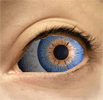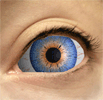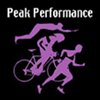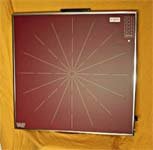This is strange, because sporting performance is strongly related to visual skill - almost 80 percent of perceptual input in sports is visual. Generally, the eyes lead and the body follows.
Blind or partially sighted athletes participate up to a high level but they would perform even better if they could see more. Similarly, normally sighted people can improve performance by using their whole visual processes to better effect. I don't mean only wearing corrective lenses but also improving other aspects of their vision when they are already wearing their best optical correction.

Sports Vision
Vision in the 'sports vision' (SV) context means far more than the ability to read the bottom line of a test chart. It certainly includes this (visual acuity) but also covers a host of other visual faculties such as dynamic vision, visual memory, eye movements, central peripheral awareness, vision reaction time, and so on - in other words, the entire visual system.
Even in running, a sport you wouldn't normally associate with good vision, it has been established that both visual acuity and the field of vision are reduced (see later under visual anticipation and central peripheral awareness).
In this and subsequent articles, each one of these parameters of vision will be discussed and I'll explain whether or not they can be trained and how.
For simplicity, I have divided the visual parameters into three separate systems:
- Those that pertain primarily to the sensory system.
- Those that concern the motor system.
- Those that are involved in mental processing or visual concentration.
All three systems must be highly in tune for good sporting performance. If one of them suffers during competition, it can have a knock-on effect on the other systems. With very fit, well-conditioned athletes, it is often concentration that falters, especially in prolonged competitions.

 Questions To Answer First ...
Questions To Answer First ...

-
Even before the physical examination, it is helpful for players and their coaches (since their perceptions are not always the same) to answer separate questionnaires, as follows:
- Do you use any visual aid? For competing? For training?
- Do you have difficulty keeping your eye on a moving object?
- Do you notice variations during your performance?
- Does your performance fall off early or late?
- Is your performance the same for night as for day competition?
- Do you have other visual difficulties when performing?
- Do you experience loss of concentration when performing?
- Inconsistent performance
- Performance not up to potential
- Performance deteriorates over time
- Performance deteriorates under mental or physical stress?
Questions For The Player:
Does The Coach Recognize Any Of The Following Signs?
Armed with this information and that gained from the ophthalmic examination as well as the SV screening, which elicits those functional visual disorders not normally discovered during a routine examination, the SV trainer identifies visual weaknesses/deficits in a player's game.
Any sports vision training (SVT) or enhancement should only be done outside the competitive season, and then only with the prior approval of the coach. Some weaknesses may not be able to be cured - for instance, color deficiency (usually wrongly called color blindness) or poor contrast sensitivity function (the ability to see clearly independent of contrast conditions) - but they can be improved.
Most weaknesses, however, can be strengthened with training. Each of the relevant visual parameters for a player can be scored on a polar graph. Not only must the graph be sport-specific (e.g., golf would not require a vision reaction time) but team-position specific (e.g., goal keeping is the only position in a football (soccer) team that needs good eye-hand coordination).
 |
 What Is A Polar Graph:? What Is A Polar Graph:?A polar graph is a graph drawn with (circular) polar coordinates. In a polar graph, points are specified in terms of absolute distance from the origin, and angle. Polar graphs are often used in the rendering of trigonometric functions. |
 |
 |
||
The purpose of SVT is to help a player score maximum points for each of the relevant visual abilities, i.e., to make as a large a circle as possible on the polar graph.
Using this type of graph makes it easy to detect strengths and weaknesses. For optimal athletic performance, there must be parallel processing of the magno and parvo neuronal systems, relating to peripheral and central vision respectively.

The Sensory Visual Parameters
 Dynamic Vision (DV):
Dynamic Vision (DV):
-
DV is the ability to see the object of regard moving when the player is stationary, e.g. a golf ball in flight, or when the object is still and the athlete is in motion, e.g. when hurdling, or when both the player and the object are in motion, e.g. a running shot in tennis.
Deficits in this ability can affect clarity, depth perception and timing. DV is processed visually by the parvo system.
Dynamic Rotator:
-
DV can be measured and trained using this instrument which, in effect, is a rotating disk. The disk consists of letters and numerals and its speed of rotation is displayed and controlled by the operator.
Initially it is set at high rpm so it cannot be read at all. The disk is then gradually slowed down until a whole line is read correctly, and then slowed down further until a cluster of letters and numbers, half the size of those previously read, is also read correctly. RPM's are recorded.
To ensure that both eyes are being used together (ocular dominance) a disk of red and green figures is used while the subject wears red/green goggles. Unless both eyes are functioning, only half the figures will be seen.
 |
Ocular Dominance Ocular Dominance was studied 60s & 70s by Nobel Prize winners Hubel & Wiesel. By depriving kittens from using one eye, they showed that columns in the primary visual cortex receiving inputs from the other eye took over the areas that would normally receive input from the deprived eye. Hubel and Wiesel's experiments showed that the ocular dominance develops irreversibly early in childhood development. These studies opened the door for the understanding and treatment of childhood cataracts and strabismus. |
 |
 |
||
The speed at which the digits are correctly identified increases with practice. This is a beneficial drill to use with both batsmen and tennis players.
Space Ball:
-
This piece of apparatus trains DV but does not measure it. However, it is more versatile than the rotator in that the letters are read when the ball moves in different configurations.
The ball, which is two-and-a-half inches in diameter, is constructed of two hemispheres, one black and the other white, upon which are green and red letters respectively.
As mentioned before, to ensure that both eyes are being trained, red/green goggles can be used. The ball, which is suspended in mid-air via a pulley, can be swung at various speeds both towards and across the player as well as high above the head or low near the ground.
In this way, the ball simulates volleys and ground strokes that are encountered in sports like squash and tennis. Among sports people at Olympic Games, ice-hockey players have shown the best DV.

 Spatial Location (SL):
Spatial Location (SL):

-
SL, which can also be considered spatial judgment or proprioception, is the ability to judge the position of an object or person in space, and often at speed, relative to oneself.
This does not need to be the same as stereoscopic vision since on many occasions only one eye may be fixating due to a side-on stance, e.g., in archery.
In the vertical jumps in athletics and in high diving, accurate SL is essential - otherwise an injury or even death may ensue. Swimmers judge when to do their tumble turns according to where they locate the end of the pool.
Some conditions render this function difficult. To judge for yourself, try locating a washing line against a background of uniform whiteness.
Brock String:
-
This simple piece of apparatus can train SL. It consists of a long string, usually 10-or-20 feet long, upon which different color beads are strung. The subject holds one end of the string with his finger at the bridge of his nose while the other end is held by the trainer.
The exercise is for the subject to quickly focus the bead of regard when it is moved in and out, as well as focusing quickly from one bead to another.
Provided the two eyes are functioning, the string should appear double and converging in a 'V' to meet at the bead of regard in all positions of gaze, e.g. up and out, down and in, etc. Being able to move the string in all directions can pinpoint errors in the visual system that would otherwise escape detection.
If the V appears nearer the bead of regard then the eyes tend to over-converge and the subject will tend to hit too soon, putt too short, etc. Conversely, if the V appears beyond the bead then the opposite is likely to occur. Inscribed on the beads are letters which enable the subject to fine tune his focusing.
If the subject has only one eye that functions centrally then only a single string will be seen, but the exercise of quickly focusing the beads when they are rapidly moved can be used, and once again in different directions of gaze, commensurate with the sporting situation.

 Central-Peripheral Awareness (CPA):
Central-Peripheral Awareness (CPA):

-
CPA is the ability to keep focused centrally while being aware of essential information around. This is not the same as tunnel vision, where there is no peripheral input. CPA is essential in almost every sport and in some, like
boxing and motor racing, can be life-saving.
If javelin throwers wear blinkers, they cannot throw properly. They need to be aware of the javelin's tip and tail and of their own place in the arena.
Archers are aware of wind conditions peripheral to the target. Tennis players during a rally watch their opponent's racket, hitting arm, etc. but are also aware of the ball they have just hit.
Even a 100-meter sprinter benefits from good CPA. An example of poor CPA occurred when Leroy Burrell, at the time the world's fastest 100m runner, had a lane in the Olympic final where, because he has only one functioning eye, he wasn't aware of the seven other runners on his blind side. He didn't win a medal. A different lane might have helped.
 |
Leroy Burell Leroy Burrell (born February 21, 1967) is an American athlete who twice set the world record for the 100 metre sprint, setting a time of 9.90 seconds in June 1991. This was then broken by Carl Lewis within a month. Burell set the record for a second time when he ran 9.85 seconds in 1994, a record that stood until 1996. |
 |
 |
||
Sports people are sometimes unaware of a failing in a particular area of their periphery. A badminton player, for example, may have a poor high-backhand due to seeing the shuttlecock late.
Both coach and player may recognize this as a player's weakness but only by the use of a Peripheral Awareness Trainer (PAT) can it be established rationally and objectively.
A primary instruction in all sports is to keep one's head as still as possible. To this I would add another: move the eyes minimally. Both rules save energy and are likely to improve performance. Peripheral awareness is processed visually by the magno system.
Peripheral Awareness Trainer (PAT):
-
The PAT is an excellent instrument for training this facility. It consists of eight 3-foot spokes radiating from a central panel. At the end of each spoke is a light-emitting diode (LED).
 |
LED A light-emitting diode (LED) is a semiconductor device that emits incoherent narrow-spectrum light when electrically biased in the forward direction. This effect is a form of electroluminescence. The color of the emitted light depends on the chemical composition of the semiconducting material used, and can be near-ultraviolet, visible or infrared. Nick Holonyak Jr. (born 1928) of the University of Illinois at Urbana-Champaign developed the first practical visible-spectrum LED in 1962. |
 |
 |
||
The LED's light up randomly and the subject fixates a central constant red light. Each time a led light, the subject is instructed to move a hand-held joystick. At the end of each complete cycle, the times taken to detect the peripheral lights in each direction are displayed.
It is useful to observe the subject's stance as well as any eye and head movement throughout the testing as this helps when analyzing the resulting data, collected after three cycles. For familiarization, the distance from PAT to subject may be six feet at first, but to obtain a better assessment of CPA, closer distances are used.
The subject soon discovers that, for faster reactions, both head and eye movements have to be kept to a minimum.
There is a practice effect and fatigue factor with all the equipment, and different layers of difficulty can be introduced when a plateau of achievement has been reached. This will be discussed later.
Since peripheral vision is reduced when running, it is useful to train on the PAT while running on the spot, to avoid too much visual field constriction.
 Pursuit Eye Movements:
Pursuit Eye Movements:

-
Pursuit Eye Movements are smooth tracking movements, one of two types of eye tracking abilities.
An illustration of this activity is following a tennis lob; another is an outfielder in a cricket match watching the ball's flight before attempting to catch it.
Pursuit movements are important in all ball sports and the throwing events in athletics; in fact, whenever a trajectory has to be followed.
Wayne Saccadic Fixator (WSF):
-
This 30-inch-square instrument consists of 33 lights set in three concentric circles around a central light. It can be used at various heights and angles to simulate playing conditions.
Usually the subject is at arms' length and is told to stand in a balanced position with feet shoulder-width apart, blink normally and keep the head as still as possible.
One of the many uses of this instrument is to practice pursuit movements by following a series of lights which appear to move in smooth motions in three modes: circularly, horizontally and vertically, while keeping the head still.
King-Devick Charts
-
These charts can be used with an overhead projector so that the size of the objects and the distance from them can be varied. Each of three charts consists of numbers, with each chart progressively more difficult to read in a flowing manner because of the increased spacing between the numerals.
Each chart is read as quickly and accurately as possible, while both errors and speed are noted to produce scores. This test simulates tracking a ball lost in flight because of floodlights or an obstacle in the line of vision.

 Saccadic Eye Movements:
Saccadic Eye Movements:


-
Saccadic Eye Movements are fast, jerky movements aimed at fixating an object on to the eye's most acute area of seeing, the foves. Table-tennis players, during rallies, are rarely far from the table and the ball is hit with such speed that only saccadic eye movements are quick enough to see the ball.
In cricket matches, close fielders have to make saccades when attempting to stop and/or catch the ball. With fatigue, saccades become less accurate; the same training instruments are used for Pursuit Eye Movements. With the Wayne Saccadic Fixator, a program of random lights set for any duration can be used to train Saccadic Eye Movements.
The subject is instructed to fixate each light as it comes on. The length of time the light stays on can be varied, the shorter the time, the harder the task. During the exercises, the SVT watches the subject's eyes to ensure correct fixation.
To train Saccadic Eye Movements, the King Devick Charts are used as before, though at a much closer distance. From this it can be seen that some instruments measure and/or train more than one vision function and similarly, a vision function can be measured and/or trained on more than one instrument.


